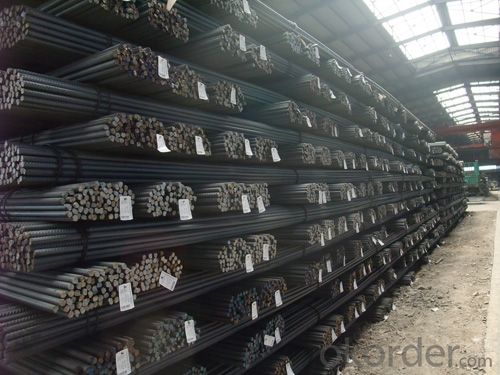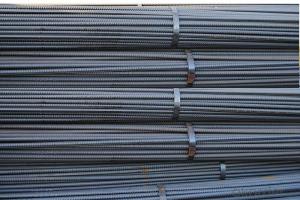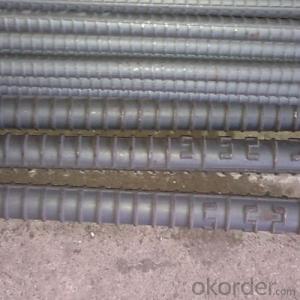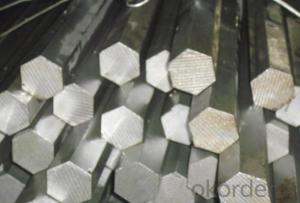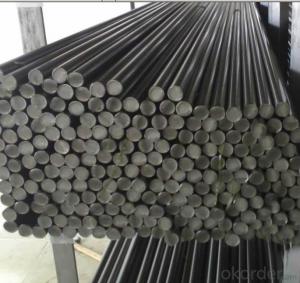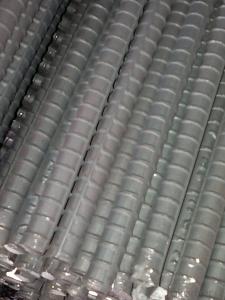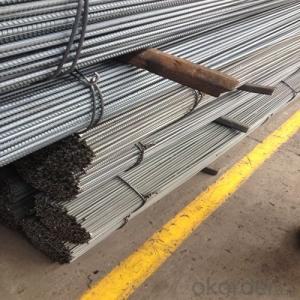HIGH QUALITY HOT ROLLED STEEL REBARBS STANDARD
- Loading Port:
- Tianjin
- Payment Terms:
- TT OR LC
- Min Order Qty:
- 50 m.t.
- Supply Capability:
- 100000 m.t./month
OKorder Service Pledge
OKorder Financial Service
You Might Also Like
Product Description:
Specifications of Hot Rolled Steel Rebar:
The production process of Steel Rebar
1-Waling beam furnace 2-Roughing rolling group 3-Intermediate rolling train
4-Finishing rolling group 5-Water-cooling device 6-Walking beam cooler
7-Finishing equipment(including the cold scale shear,short feet collection system,
automatic counting device,bundling machine, collect bench)
Usage and Applications of Hot Rolled Steel Rebar:
Deformed bar is widely used in buildings, bridges, roads and other engineering construction. Big to highways, railways, bridges, culverts, tunnels, public facilities such as flood control, dam, small to housing construction, beam, column, wall and the foundation of the plate, deformed bar is an integral structure material. With the development of world economy and the vigorous development of infrastructure construction, real estate, the demand for deformed bar will be larger and larger..
Packaging & Delivery of Hot Rolled Steel Rebar:
Packaging Detail: products are packed in bundle and then shipped by container or bulk vessel, deformed bar is usually naked strapping delivery, when storing, please pay attention to moisture proof. The performance of rust will produce adverse effect.
Each bundle weight: 2-3MT, or as required
Payment terms: TT payment in advance or Irrevocable LC at sight.
Trade terms :FOB, CFR, CIF
Label:to be specified by customer, generally, each bundle has 1-2 labels
Note:
1. Our products are produced according to national standard (GB), if not, supply according to national standards (GB) or agreement as customer required.
2. Other Grade and Standard Deformed Steel Bar we can supply:
Grade: GR40/GR60, G460B/B500A/B500B/B500C,BST500S
Standard: ASTM, BS, DIN
The Minimum Order Quantity of these products is high, and need to be confirmed.
3. We can not only supply Deformed Steel Bar; if you need anything about building materials, please contact us for further information.
4. Please send us your detail specifications when inquire. We will reply to you as soon as possible. We sincerely hope we can establish a long stable business relationship.
- Q: Are steel rebars suitable for use in structures with high resistance to chemicals?
- Steel rebars are generally not suitable for use in structures with high resistance to chemicals. While steel is a strong and durable material, it is susceptible to corrosion when exposed to certain chemicals. Chemicals such as acids, alkalis, and chlorides can cause steel rebars to corrode, which can compromise the structural integrity of the building or structure. To ensure high resistance to chemicals, alternative materials such as stainless steel rebars or fiber-reinforced polymer (FRP) rebars are often used. Stainless steel rebars are more resistant to corrosion than regular steel rebars due to their higher chromium content. FRP rebars, on the other hand, are non-metallic and do not corrode, making them a suitable choice for structures exposed to harsh chemical environments. Ultimately, the choice of rebars in structures with high resistance to chemicals depends on the specific chemicals involved and the level of exposure. It is important to consult with engineers and experts who can assess the chemical environment and recommend the most suitable rebars to ensure the long-term durability and safety of the structure.
- Q: How are steel rebars used in reinforcement cages?
- Steel rebars are used in reinforcement cages to provide strength and stability to concrete structures. They are placed in a grid-like pattern and then tied together to form a cage-like structure. These rebars help to distribute the load evenly throughout the structure, preventing cracks and improving its overall strength.
- Q: Can steel rebars be welded together?
- Yes, steel rebars can be welded together using various welding processes such as shielded metal arc welding (SMAW), gas metal arc welding (GMAW), or flux-cored arc welding (FCAW). Welding rebars together is a common practice in construction to create a structural joint that ensures strength and stability in reinforced concrete structures.
- Q: The difference between rebar and crescent
- Rebar -- steel used in concrete structures with a generally rounded cross section and ribbed surface.Longitudinal ribs -- uniform continuous ribs parallel to the axis of the steel bar -- other ribs not parallel to the axis of the reinforcement.The longitudinal section of crescent ribbed bars -- transverse rib reinforced crescent, and does not intersect with longitudinal ribs.
- Q: What is the effect of moisture content on the strength of steel rebars?
- The strength of steel rebars can be significantly affected by their moisture content. When exposed to moisture, particularly water or high humidity, corrosion can occur. This happens when the moisture reacts with the iron in the steel, resulting in the formation of iron oxide or rust. As a result, the steel rebars weaken and their overall strength is reduced. Moisture presence speeds up the corrosion process, causing the gradual loss of structural integrity in the steel rebars. Corroded rebars become brittle and are more prone to fractures or failure when subjected to a load. This can be especially problematic in construction projects that utilize steel rebars to reinforce concrete structures, as the corrosion compromises the durability and safety of the entire structure. Moisture not only directly impacts the strength, but it also contributes to other issues such as cracking, spalling, and concrete degradation. When moisture interacts with the concrete surrounding the steel rebars, it leads to expansion and contraction, resulting in internal stress and potential damage. This further weakens the rebars and the overall structure. To counteract the negative effects of moisture on steel rebars, several protective measures can be adopted. These measures may include the use of corrosion-resistant coatings like epoxy or zinc, which act as a barrier between the rebars and moisture. Additionally, ensuring proper drainage and ventilation in construction projects can prevent the accumulation of moisture, reducing the risk of corrosion and maintaining the strength and longevity of the steel rebars. In conclusion, it is vital to carefully consider the moisture content and its potential impact on steel rebars in any construction project. By addressing and managing moisture, engineers and builders can guarantee the structural integrity and safety of the steel rebars, ultimately improving the strength and durability of the entire structure.
- Q: Can steel rebars be used in bridge deck construction?
- Yes, steel rebars can be used in bridge deck construction. Rebars, also known as reinforcement bars, are typically made of carbon steel and are used to reinforce concrete structures, including bridge decks. They are commonly used in bridge deck construction because of their high tensile strength and ability to withstand heavy loads. The rebars are placed within the concrete deck to provide additional strength and prevent cracking. They act as a reinforcement to distribute the load evenly across the bridge deck, increasing its load-bearing capacity and durability. Steel rebars are also resistant to corrosion, which is essential in bridge construction due to exposure to harsh environmental conditions, such as moisture, salt, and temperature fluctuations. In addition to their structural benefits, steel rebars offer flexibility in design and construction. They can be easily shaped, bent, and tied together, allowing for customized positioning and reinforcement of the bridge deck. This flexibility enables engineers to optimize the design and ensure the bridge deck meets the required strength and safety standards. Overall, steel rebars are a commonly used and suitable choice for bridge deck construction due to their high strength, corrosion resistance, and flexibility in design. They play a crucial role in enhancing the structural integrity and longevity of bridge decks, making them a reliable and preferred option in bridge construction projects.
- Q: Can steel rebars be used in the construction of data centers and server rooms?
- Yes, steel rebars can be used in the construction of data centers and server rooms. Steel rebars are commonly used in reinforced concrete structures to provide strength and stability. In the construction of data centers and server rooms, where the infrastructure needs to support heavy equipment and withstand high loads, steel rebars can be used to reinforce the concrete floors, walls, and columns, ensuring the structural integrity of the facility.
- Q: Can steel rebars be used in infrastructure projects?
- Yes, steel rebars can be used in infrastructure projects. They are commonly used in construction projects to reinforce concrete structures such as bridges, buildings, and highways. Steel rebars add strength and durability to the concrete, making it capable of withstanding heavy loads and harsh environmental conditions.
- Q: Can steel rebars be used in underwater structures?
- Yes, steel rebars can be used in underwater structures. Steel rebars are commonly used in construction projects to reinforce concrete structures and provide additional strength and stability. When it comes to underwater structures, such as bridges, dams, and offshore platforms, the use of steel rebars is crucial due to their excellent strength and durability. However, the use of steel rebars in underwater structures requires additional considerations. One of the main concerns is corrosion, as exposure to water and salt can accelerate the corrosion process. To mitigate this issue, corrosion-resistant steel rebars, such as stainless steel or epoxy-coated rebars, are used. These rebars have protective layers that prevent direct contact between the steel and water, minimizing the risk of corrosion. Furthermore, proper design and construction techniques are essential when using steel rebars in underwater structures. Adequate concrete cover and proper spacing between rebars are crucial to ensure sufficient protection against corrosion and maintain the structural integrity of the underwater structure. Additionally, regular inspection and maintenance are necessary to identify and address any signs of corrosion or deterioration in the rebars. In conclusion, steel rebars can be used in underwater structures, but it requires careful consideration of corrosion protection measures and adherence to proper design and construction practices. With the right precautions in place, steel rebars can provide the necessary strength and durability for underwater structures.
- Q: What are the potential risks of using steel rebars in construction?
- Some potential risks of using steel rebars in construction include corrosion, inadequate bonding with concrete, and potential for structural failure if not properly installed or maintained. Additionally, steel rebars can conduct electricity, posing a risk in areas with electrical currents or lightning storms.
Send your message to us
HIGH QUALITY HOT ROLLED STEEL REBARBS STANDARD
- Loading Port:
- Tianjin
- Payment Terms:
- TT OR LC
- Min Order Qty:
- 50 m.t.
- Supply Capability:
- 100000 m.t./month
OKorder Service Pledge
OKorder Financial Service
Similar products
Hot products
Hot Searches
Related keywords




